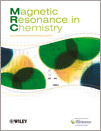
Solid-state NMR (ssNMR) spectroscopy is a technique for characterizing atomic level structure in solid materials e.g. powders, single crystals and amorphous samples and tissues using nuclear magnetic resonance (NMR) spectroscopy. The anisotropic part of many spin interactions are present in solid-state NMR, unlike in solution-state NMR where rapid tumbling motion averages out many of the spin interactions. As a result, solid-state NMR spectra are characterised by larger linewidths than in solution state NMR, which can be utilized to give quantitative information on the molecular structure, conformation and dynamics of the material. Solid-state NMR is often combined with magic angle spinning to remove anisotropic interactions and improve the resolution as well as the sensitivity of the technique.
Adriaan "Ad" Bax is a Dutch-American molecular biophysicist. He was born in the Netherlands and is the Chief of the Section on Biophysical NMR Spectroscopy at the National Institutes of Health. He is known for his work on the methodology of biomolecular NMR spectroscopy.

Sodium trimethylsilylpropanesulfonate (DSS) is the organosilicon compound with the formula (CH3)3SiCH2CH2CH2SO3−Na+. It is the sodium salt of trimethylsilylpropanesulfonic acid. A white, water-soluble solid, it is used as a chemical shift standard for proton NMR spectroscopy of aqueous solutions. The chemical shift, specifically the signal for the trimethylsilyl group, is relatively insensitive to pH.

Magnetic Resonance in Chemistry is a monthly peer-reviewed scientific journal covering the application of NMR, ESR, and NQR spectrometry in all branches of chemistry. The journal was established in 1969 and is published by John Wiley & Sons. The editors-in-chief are Roberto R. Gil and Gary E. Martin.
NMR in Biomedicine is a monthly peer-reviewed medical journal published since 1988 by John Wiley & Sons. It publishes original full-length papers, rapid communications, and review articles in which magnetic resonance spectroscopy or imaging methods are used to investigate physiological, biochemical, biophysical, or medical problems. The current editor-in-chief is John R. Griffiths.
Herbert Sander Gutowsky was an American chemist who was a Professor of Chemistry at the University of Illinois Urbana-Champaign. Gutowsky was the first to apply nuclear magnetic resonance (NMR) methods to the field of chemistry. He used nuclear magnetic resonance spectroscopy to determine the structure of molecules. His pioneering work developed experimental control of NMR as a scientific instrument, connected experimental observations with theoretical models, and made NMR one of the most effective analytical tools for analysis of molecular structure and dynamics in liquids, solids, and gases, used in chemical and medical research, His work was relevant to the solving of problems in chemistry, biochemistry, and materials science, and has influenced many of the subfields of more recent NMR spectroscopy.
Raymond Freeman FRS was a British chemist and professor at Jesus College, Cambridge who made important contributions to NMR spectroscopy.

The Journal of Magnetism and Magnetic Materials is a peer-reviewed scientific journal that covers both basic research on magnetism and technological applications including magnetic recording. In addition to full-length research articles, it publishes review articles and rapid communications. A special section, "Information Storage: Basic and Applied", covers topics on magnetic media. The editor-in-chief is S. D. Bader.
Triple resonance experiments are a set of multi-dimensional nuclear magnetic resonance spectroscopy (NMR) experiments that link three types of atomic nuclei, most typically consisting of 1H, 15N and 13C. These experiments are often used to assign specific resonance signals to specific atoms in an isotopically-enriched protein. The technique was first described in papers by Ad Bax, Mitsuhiko Ikura and Lewis Kay in 1990, and further experiments were then added to the suite of experiments. Many of these experiments have since become the standard set of experiments used for sequential assignment of NMR resonances in the determination of protein structure by NMR. They are now an integral part of solution NMR study of proteins, and they may also be used in solid-state NMR.

The chemical shift index or CSI is a widely employed technique in protein nuclear magnetic resonance spectroscopy that can be used to display and identify the location as well as the type of protein secondary structure found in proteins using only backbone chemical shift data The technique was invented by David S. Wishart in 1992 for analyzing 1Hα chemical shifts and then later extended by him in 1994 to incorporate 13C backbone shifts. The original CSI method makes use of the fact that 1Hα chemical shifts of amino acid residues in helices tends to be shifted upfield relative to their random coil values and downfield in beta strands. Similar kinds of upfield and downfield trends are also detectable in backbone 13C chemical shifts.

Gareth Alun Morris FRS is a Professor of Physical Chemistry, in the School of Chemistry at the University of Manchester.

Professor Ramakrishna Vijayacharya Hosur is an Indian biophysical scientist, known for his expertise in the areas of nuclear magnetic resonance and molecular biophysics. The Government of India honoured him, in 2014, by awarding him the Padma Shri, the fourth highest civilian award, for his contributions to the fields of science and technology.

Geoffrey Bodenhausen is a French chemist specializing in nuclear magnetic resonance, being highly cited in his field. He is a Corresponding member of the Royal Netherlands Academy of Arts and Sciences and a Fellow of the American Physical Society. He is professeur émérite at the Department of Chemistry at the École Normale Supérieure (ENS) in Paris and professeur honoraire at the Laboratory of Biomolecular Magnetic Resonance of the École Polytechnique Fédérale de Lausanne (EPFL). He is a member of the editorial board of the journal Progress in Nuclear Magnetic Resonance Spectroscopy. He is the chair of the editorial board of the journal Magnetic Resonance.
Hyperpolarized carbon-13 MRI is a functional medical imaging technique for probing perfusion and metabolism using injected substrates.
The Russell Varian Prize was an international scientific prize awarded for a single, high-impact and innovative contribution in the field of nuclear magnetic resonance (NMR), that laid the foundation for the development of new technologies in the field. It honored the memory of Russell Varian, the pioneer behind the creation of the first commercial NMR spectrometer and the co-founder, in 1948, of Varian Associates, one of the first high-tech companies in Silicon Valley. The prize carried a monetary award of €15,000 and it was awarded annually between the years 2002 and 2015 by a committee of experts in the field. The award ceremony alternated between the European Magnetic Resonance (EUROMAR) Conference and the International Council on Magnetic Resonance in Biological Systems (ICMRBS) Conference. Originally, the prize was sponsored by Varian, Inc. and later by Agilent Technologies, after the latter acquired Varian, Inc. in 2010. The prize was discontinued in 2016 after Agilent Technologies closed its NMR division.
Sandra Eaton is an American chemist and Professor at the University of Denver, known for her work on electron paramagnetic resonance.
Malcolm Harris Levitt is a British physical chemist and nuclear magnetic resonance (NMR) spectroscopist. He is Professor in Physical Chemistry at the University of Southampton and was elected a Fellow of the Royal Society in 2007.

Jörg Kärger is a German physicist.

Rolf Gruetter is a Swiss physicist and neurobiologist specialized in magnetic resonance, biomedical imaging and brain metabolism. He is a professor of physics at EPFL and the head of the Laboratory Functional and Metabolic Imaging at the School of Basic Sciences.
Clinical Radiology is a medical journal that covers the aspects of clinical radiology, including: computed tomography, magnetic resonance imaging, ultrasonography etc. The journal is published by Elsevier.










